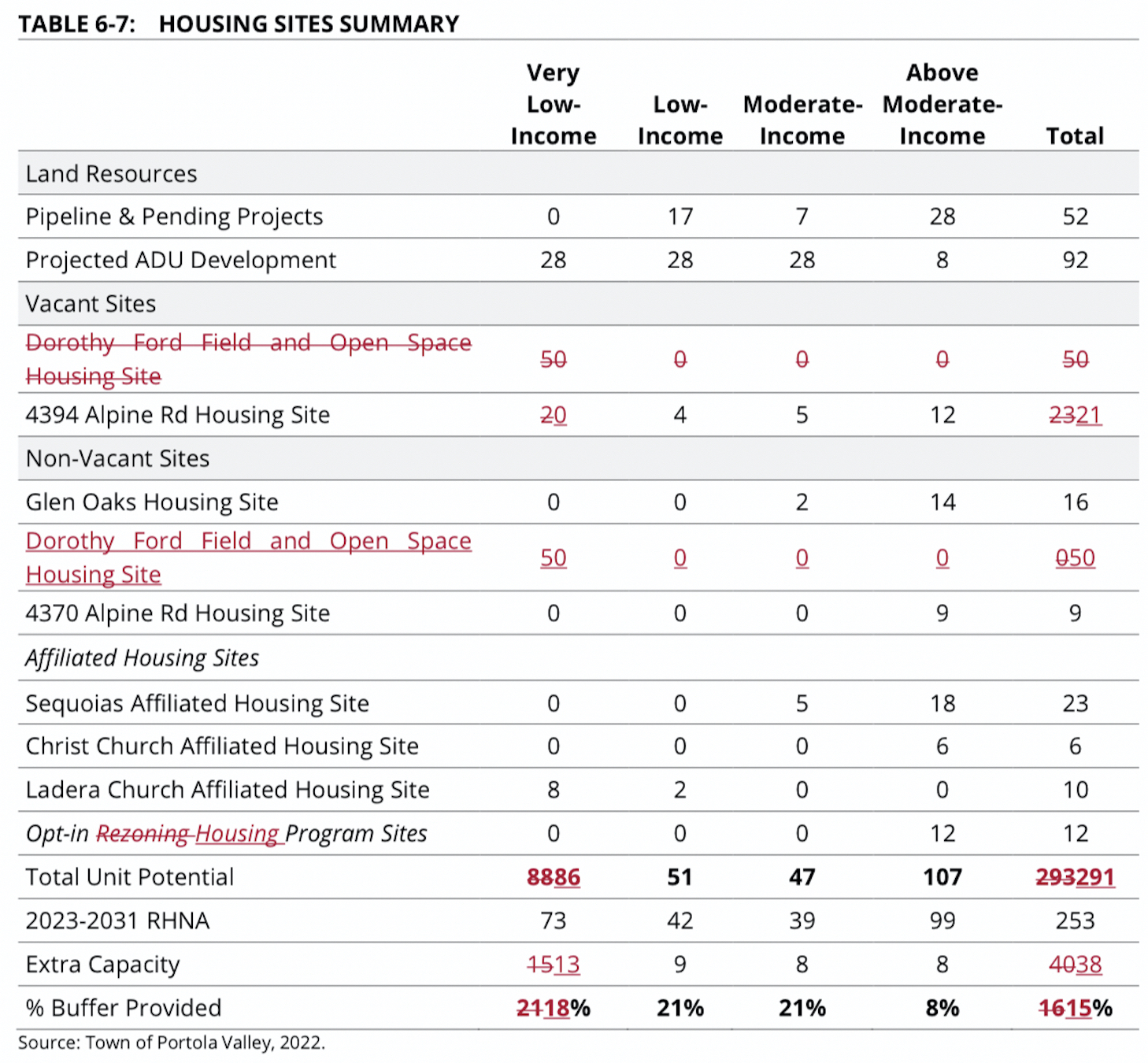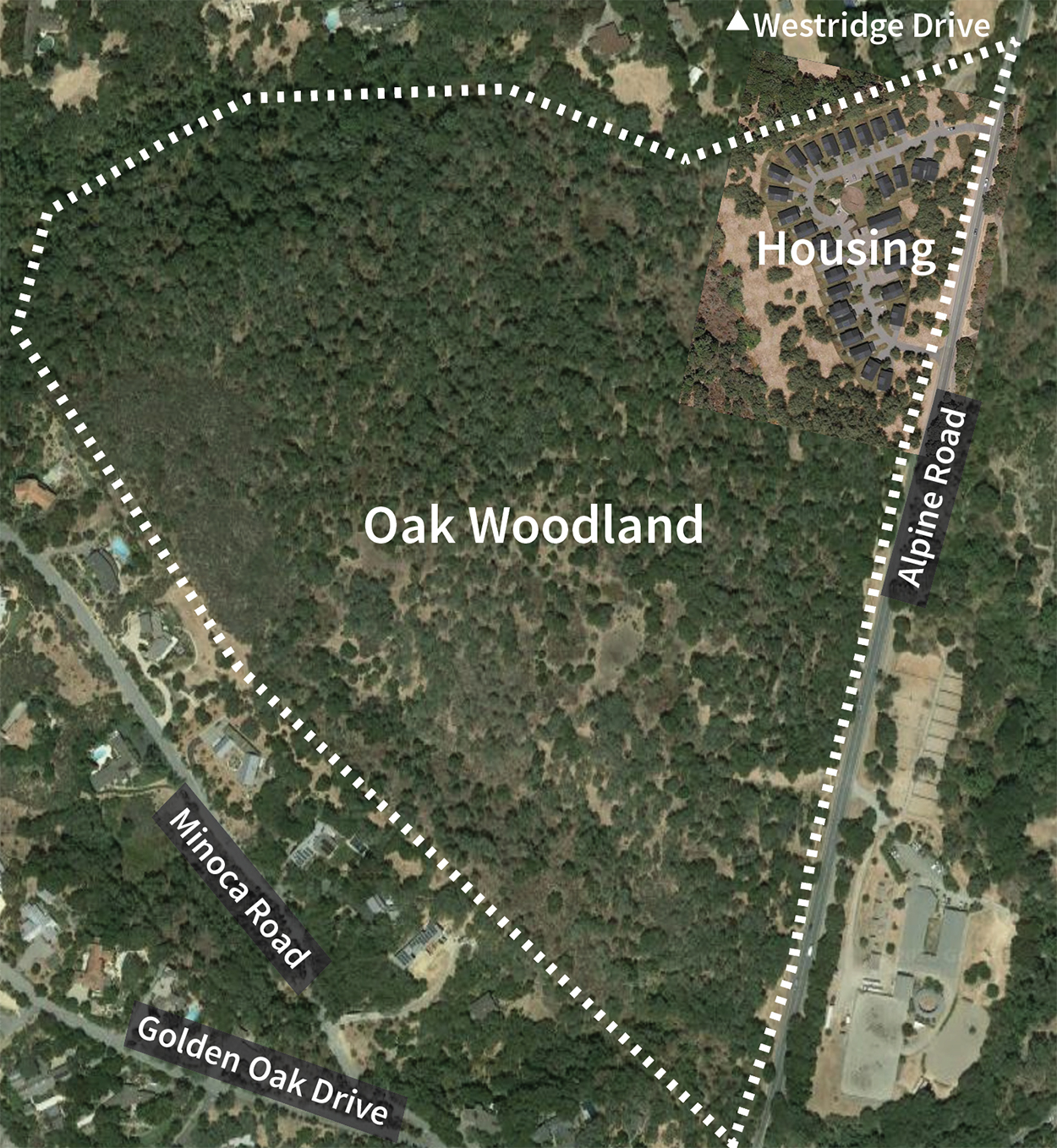The latest iteration of Portola Valley's draft housing element is up for review by town officials, after punting on submitting the state-mandated document in late January. The draft, which is expected to be adopted on March 29, has few changes, but reveals more about future development plans for sites in the town.
On Jan. 25, the Town Council directed staff not to submit the housing element by the Jan. 31 deadline, because they said the plans were not ready. At the time, other Bay Area cities were rushing to submit compliant elements to the state at the end of January. Portola Valley is required to plan for 253 new units that could reasonably be built between 2023 and 2031 as part of the 2023-31 Regional Housing Needs Allocation (RHNA).
The draft changes the classification of Dorothy Ford Field, where 50 units of housing are planned at 20 units per acre, from vacant to non-vacant land. It also requires a general plan amendment to allow for rezoning the 2.48-acre site.
Vice Mayor Sarah Wernikoff said that HCD (the state's Department of Housing and Community Development) has a strict definition of "vacant" that does not equate to common usage. The site includes the baseball diamond and even though the baseball diamond would remain or be improved with the project, the town thought it was best to strictly comply with the HCD guidance, she said.
The descriptions of the sites at 4394 Alpine Road and 4370 Alpine Road in Nathhorst Triangle were updated substantially following concerns from the owner and neighbors, respectively, according to staff.
The Planning Commission discussed the new plan during a four-and-half hour meeting on Monday, March 6.
4394 and 4370 Alpine Road
The housing plan was updated to include the fact that there is no housing planned yet for 4394 Alpine Road.
The Portola Valley residents who own the Willow Commons project at 4388 Alpine Road acquired the adjacent 4394 Alpine Road property in 2021. The owners have not yet developed a housing plan for the site, but could do so in the coming years. The owners plan to use the property to support their philanthropic mission of building permanent affordable housing for adults with intellectual and developmental disabilities.
"The owners have surveyed supportive housing models throughout the United States and hope to bring a collection of best practices to this new site," according to the draft. "Some of the options being considered are a stand-alone supportive housing site similar to the project at 4388 Alpine; development of additional supportive housing programs to complement 4388 Alpine; development of other housing models (e.g., shared housing) that address vulnerable populations; or a combination of these or other alternatives."
The applicants are also exploring some mixed use ideas, such as retail or an art gallery, that would provide both job training and revenue, and a mixture of market rate housing units to provide integration of tenant populations and additional revenue to cross-subsidize the below-market units, according to staff.
"The town desires to support and facilitate the owners' philanthropic efforts and recognizes this is a rare opportunity to showcase that a vital, yet scarce, form of housing can be developed in the core of an affluent, suburban community," the new draft states.
The plan now specifies that 4370 Alpine is an abandoned tennis court and unused parking lot, along with an office. The main issue at this site is Nathhorst neighbors who voiced concerns about increased density in their neighborhood, according to a March 6 staff presentation to the Planning Commission.
Town consultant Lisa Wise Consulting prepared an early concept plan demonstrating that 20 units per acre would be feasible with complete redevelopment of the site. The Ad Hoc Housing Element Committee came to a different conclusion, finding that the site would be appropriate with six units per acre (with a total of nine units) and recommended a new mixed-use district. The town's site inventory estimates nine townhouses could be developed, with five units developed in the back and four in the front.
Property owner Richard Thesing has also expressed interest in redeveloping it in meetings with staff. His plans focused on the rear portion of the property, showing that up to 11 units (consisting of nine three-bedroom units of 1,782 square feet and two, one-bedroom accessory dwelling units) could be developed on the rear portion. The development potential of the site is much higher if it's included as a housing site, and the property owner has significant financial incentive to develop residential units, according to the element.
Thesing told the Planning Commission during the March 6 review of the plan that he doesn't think it's feasible to build four units of housing at the front of the property because of nearby office buildings that aren't going to be torn down.
The plan also now includes building setbacks at the site.
Nathhorst residents Bob Adams and Bill Russell thanked the town for working with residents and making compromises on the sites in his neighborhood during the Planning Commission review.
Fire risk and resident feedback
The latest draft also indicates the fire hazard on each proposed site.
For example, The Sequoias is characterized as fire-prone oak woodland (highest hazard) and fire-prone urban forest (high hazard). Christ Church is on mowed grass (low) and fire-prone urban forest (high). The Stanford Wedge is described as fire-prone urban forest (highest) and chaparral (highest).
Fire mitigation efforts while developing the sites could change the fire risk of each location though.
Overall residents were complimentary of town staff's work to refine the housing element plan during the Planning Commission meeting.
Some residents said they didn't feel like they were given enough time to review the new draft, released on Thursday, March 2, for the March 6 Planning Commission review.
Residents also asked for larger setbacks at several of the sites.
Resident Rita Comes said she was disappointed by inaccuracies in the draft, including misidentifying Dorothy Ford Park as Dorothy Ford Field.
Next steps
The plan will next be reviewed at a Wednesday, March 15, Town Council study session. The council will consider adopting an initial study/mitigated negative declaration at a March 22 meeting. The council will then consider adopting the draft housing element at a March 29 meeting.
Read the full draft here.
Watch a video of the Planning Commission meeting here.






Comments